
Managing lower back pain
Lower back pain is one of the most common health problems we face. According to the National Institutes of Health, eight out of 10 people will experience it at some point in their life, and it is a common cause of activity limits in people of all ages.
Craig Higgs, MD, an internal medicine and pediatric provider with OSF Medical Group, said muscular strains are the most common cause of low back pain in younger adults. However, normal aging and some physically demanding occupations can also cause discs to wear out. Arthritis, bad posture and poor movement patterns can speed up the process.
When it’s more than a sprain
While lower back pain is usually not life-threatening, there are some “red flags” that would warrant evaluation and diagnostic imaging, including:
- Fever or other symptoms of infection
- Redness around the site of back pain
- History or symptoms concerning a fracture (severe injury or trauma)
- Known malignancy signs, such as unintentional weight loss or a history of cancer with back pain
- Loss of control of bowels or bladder
- Loss of sensation in the lower extremities
- Saddle anesthesia (loss of sensation in the buttocks, perineum and inner thighs)
- Sudden, significant or progressive weakness of the lower extremities (such as inability to raise the toes or foot)
If you are experiencing any of the “red flag” symptoms, you should be evaluated immediately. You should also be assessed if the pain is severe enough to limit usual activity, such as work and general activities, or if the pain is not improving with conservative measures.
Trauma, such as a car accident, with severe pain and any other red flag symptoms, would warrant an evaluation in the emergency department. If you cannot pass urine, you may also need to go to the emergency room, as you may need urgent intervention.
“If there is focal bone pain, we do need to think about fractures. These can be from trauma such as falls or accidents, insufficiency such as in osteoporosis or stress fractures that are sometimes seen in younger athletes,” Dr. Higgs said. “In older patients, malignancy is also a consideration, particularly in patients with known cancer. Infections can happen, as well, but are rare and would be associated with other symptoms of infection, such as fever.”
Identifying the problem
The exact cause of low back pain can be hard to determine. The pain may be a symptom of many different possible causes, including overuse, injury, spinal degeneration or slipped disk.
Big questions that come up frequently are whether X-rays or MRIs are needed and when.
“Most people don’t need imaging initially in the absence of any of the ‘red flag’ symptoms,” Dr. Higgs said. “I think it’s important for providers to explain why this is not usually necessary. We can get people better with conservative management without imaging most of the time.
“In the event of acute trauma, a history of osteoporosis or other risks for an insufficiency or compression fracture, or other concerns for fracture or malignancy, then X-rays are usually warranted.”
Dr. Higgs also warns that if there are acute signs of neurologic compromise such as foot drop, numbness or tingling in the legs or bowel and bladder dysfunction, an MRI may be warranted. Otherwise, most suffering from back pain should engage in conservative treatment plans first.
The other reason for imaging would be a back pain that hasn’t improved in a timely fashion with conservative measures, such as physical therapy and anti-inflammatories.
What you can do about lower back pain
Fortunately, while unpleasant, most low back pain is not severe or life-threatening, and the pain will improve with time and conservative or noninvasive management, including:
- Good posture
- Losing weight
- Reducing stress
- Staying active
- Quit smoking
If pain is persistent, over-the-counter medicines, such as acetaminophen, ibuprofen or naproxen may be beneficial for those who can take them safely.
Dr. Higgs encourages using ice for injury, pain and inflammation or heat to help loosen tight muscles. You can help prevent injury or chronic strain by modifying your lifting technique, posture and workspace ergonomics.
“While it may seem counterintuitive, one of the most important things for common musculoskeletal back pain is to stay active. Bedrest may slow recovery,” Dr. Higgs said. “However, avoidance of activities that significantly aggravate pain, such as bending or heavy lifting, is important.”
If you are experiencing lower back pain, contact a primary care provider or visit an urgent care clinic to determine your next steps.
